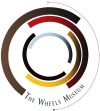An Assessment of Significance
Chris Wilson
Industrial Construction
The decade from 1914 to 1924, when
the new Albuquerque shops were constructed, coincided with the greatest
period of innovation in the history of industrial design and building
technology. Factories of the late 19th century had followed a building
tradition which stretched back to medieval warehouses.
Because of high property values in cities, these factories were customarily multi-story buildings. Generally they had stone or brick, load-bearing piers outside and heavy timber framing inside. (The original Atlantic and Pacific roundhouse and shops were stone construction with timber framing.) Concrete reinforced with steel became common in industrial construction after 1905, It was fire-proof, required less maintenance than brick or stone, dampened machine vibration better and was faster and more economical to build. Since the structure was reduced to a minimum with reinforced concrete, large areas of the walls were left free for windows to better light the factory. (10)
The need to build even more quickly during the First World War, spurred the adoption of steel frame construction. Steel had not been used earlier in multi-story factories because it failed if exposed to fire, and did not provide dampening for machine vibration, So war-time factories were shifted to less-expensive property away from city centers where it was economical to build one-story buildings and safe to use steel. Besides being faster and cheaper to build, steel structures left even more wall surface free for light and ventilation and also spanned greater widths than reinforced concrete. This last characteristic allowed greater flexibility to design an enclosure around the industrial process. The process could be laid out for maximum efficiency without being constrained by the smaller structural grid of reinforced concrete. (11)
Because the Albuquerque shops were constructed both before and after the First World War, they reflect several stages of this rapid evolution. Some smaller buildings such as the locker and wash rooms are of brick, while the Sheet Metal Shed has a wood timber structure. Reinforced concrete was used for the Roundhouse, Storehouse and Flue Shop built just before the war, and for most of the smaller, auxiliary buildings. The Blacksmiths Shop, built about 1917, employs a steel frame structure but retains vestigial brick walls. The Machine and Boiler Shops, built after the war, employ a steel frame, with spans as wide as 86 feet, and continuous glass curtain walls on the long east-vest sides.
Roundhouse In addition to using a new material, the 35-stall Roundhouse also followed a standardized plan designed by the Santa Fe’s engineering department in Chicago. This plan detailed the construction of a single stall which could be multiplied to produce the number of stalls needed for each new roundhouse. The standard plan is dated May, 1914, while the layout of the Albuquerque Roundhouse is dated May 22, 1914, making it an early, perhaps the first, use of this new Santa Fe system standard plan. A tall center section, cutting across the middle of each stall, allowed the addition of two improvements: clerestory windows which provided better light and a 7 1/2 ton traveling crane which facilitated minor locomotive repairs.
Although this was a substantial advance over the poorly-lit, old sandstone roundhouse, the new roundhouse exhibits some features which had become conventional in 19th century roundhouses such as steam heat pipes in the engine pits and an elaborate drainage system to facilitate cleaning. The concrete detailing under the monitor roof, too, harkens back to the rafters of early, wooden roundhouse roofs. (12)
